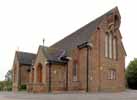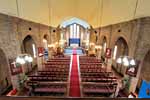 Mansfield (Ladybrook) Mansfield (Ladybrook)
St Mary
Archaeology
The building comprises nave with north and south aisles, north transept, north porch, west gallery, chancel, and vestry-kitchen annexe at the south-east angle.
The church was constructed on farmland south of the Lady Brook; there is no evidence for any other use of the land prior to construction.
Construction is entirely of red brick and slate with some concrete cappings and brackets. The date is uniformly 1955-7. The external cast-iron rainwater hoppers are dated 1955.
 The church from the The church from the
north-west |
 The interior The interior
looking east |
Architectural style is broadly neo-Norman with round-headed openings, except for the vestry, porch side walls, and lower west windows which are plain rectangles. The aisle arcades are also round-headed. Externally stretcher bond has been used for the side walls, whilst internally English bond is employed, evidently to create a more visually pleasing effect.
Technical Summary
Timbers and roofs
|
NAVE |
CHANCEL |
TOWER |
| Main |
Pitched, internally across four angles, plastered concealing timber structure. All 1955-57. |
Pitched, internally across four angles, plastered concealing timber structure. All 1955-57. |
n/a |
| S.Aisle |
Plastered, part sloping, part flat, concealing timbers. All 1955-57. |
n/a |
|
| N.Aisle |
Plastered, part sloping, part flat, concealing timbers. All 1955-57. |
n/a |
|
| Other principal |
North porch has part flat, part sloping ceiling, plastered. All 1955-57. |
|
|
| Other timbers |
|
|
|
Bellframe
Single bell of 1955, simply hung in western brick turret with timber sloping sides, probably of 1957.
Walls
|
NAVE |
CHANCEL |
TOWER |
| Plaster covering & date |
Open brickwork, except plastered lower west wall; 1955-57 |
Open brickwork; 1955-57 |
n/a |
| Potential for wall paintings |
None. |
None. |
n/a |
Excavations and potential for survival of below-ground archaeology
There have been no known archaeological excavations.
The standing fabric of the church dates entirely from a single phase of building in 1955-57 on a site that was open field space previously. It is expected that below-ground stratigraphy will be uniformly that of the construction phase of 1955-57.
The standing fabric of the entire building has some importance as a complete 1950s estate church.
The churchyard is approximately triangular, with the church positioned towards the south-west side. There are no burials.
The overall potential for the survival of below-ground pre-1955 archaeology in the church and churchyard, is considered to be UNKNOWN. The standing fabric of the church is of a single phase of 1955-57 and has had little alteration since that date. It therefore has potential for 1950s archaeology in the standing fabric which is considered to be HIGH.
Exterior: No burials, potential for pre-church archaeology but this is unknown.
Interior: Stratigraphy under the entire interior of the building is expected to comprise construction layers dating from 1955-57.
|